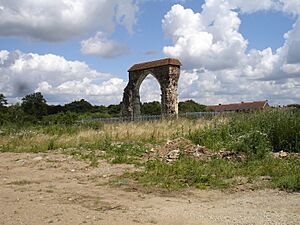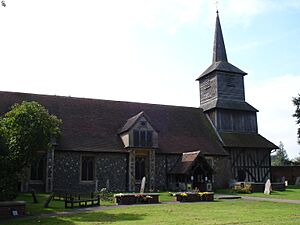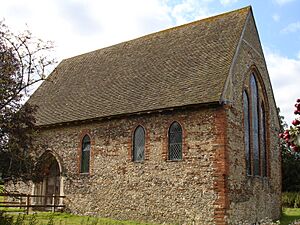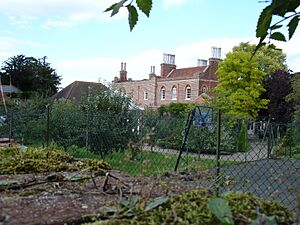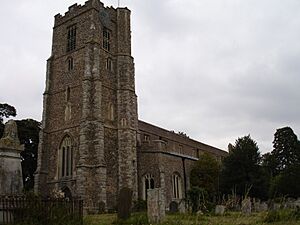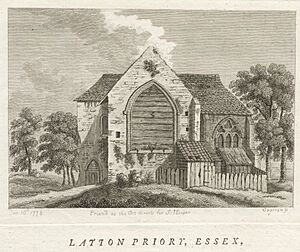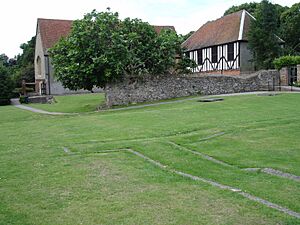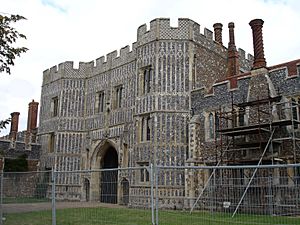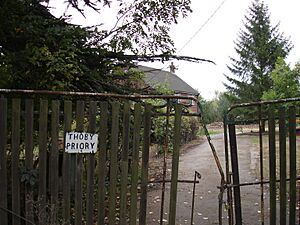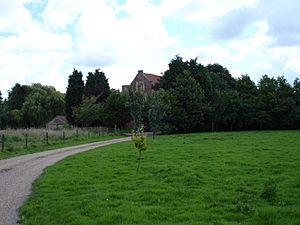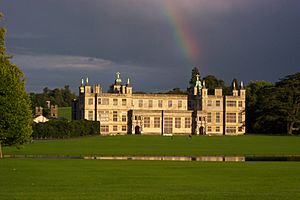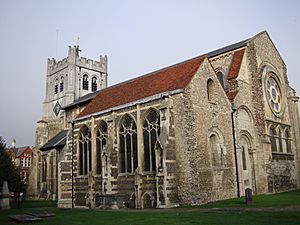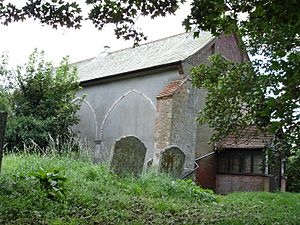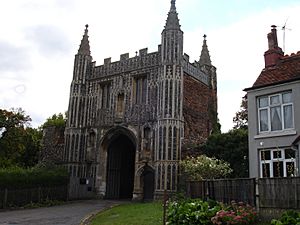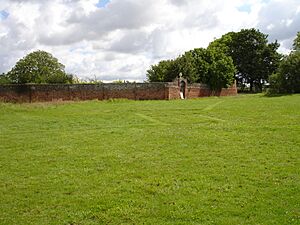List of monastic houses in Essex facts for kids
This page lists the monastic houses that once existed in Essex, England. Monastic houses were places where groups of people, like monks, nuns, or friars, lived together under religious rules. They dedicated their lives to prayer, study, and work. These places played a big role in history, often serving as centers for learning and charity.
Alien houses are included, as are smaller establishments such as cells and notable monastic granges (particularly those with resident monks), and also camerae of the military orders of monks (Knights Templars and Knights Hospitaller). Monastic hospitals are included where they had the status or function of an abbey, priory, friary or preceptor/commandery.
- Abbreviations and key
| Symbol | Status |
|---|---|
| None | Ruins |
| * | Current monastic function |
| + | Current non-monastic ecclesiastic function (including remains incorporated into later structure) |
| ^ | Current non-ecclesiastic function (including remains incorporated into later structure) or redundant intact structure |
| $ | Remains limited to earthworks etc. |
| # | No identifiable trace of the monastic foundation remains |
| ~ | Exact site of monastic foundation unknown |
| ≈ | Identification ambiguous or confused |
Locations with names in italics indicate possible duplication (misidentification with another location) or non-existent foundations (either erroneous reference or proposed foundation never implemented) or ecclesiastical establishments with a monastic name but lacking actual monastic connection.
| EH | English Heritage |
| LT | Landmark Trust |
| NT | National Trust |
Contents
- Monastic Houses in Essex
- Ancient Monasteries and Early Communities
- Abbeys and Priories in Essex
- Beeleigh Abbey
- Berden Priory
- Bicknacre Priory
- Blackmore Priory
- Castle Hedingham Priory
- Coggeshall Abbey
- Earl's Colne Priory
- Hatfield Broad Oak Priory
- Hatfield Peverel Priory
- Latton Priory
- Leez Priory
- Little Dunmow Priory
- Little Horkesley Priory
- Panfield Priory
- Parndon Abbey
- Prittlewell Priory
- St Osyth's Abbey
- Stansgate Priory
- Takeley Priory
- Thoby Priory
- Thremhall Priory
- Tilty Abbey
- Tiptree Priory
- Walden Abbey
- Waltham Abbey
- West Mersea Priory
- Wix Priory
- Friaries and Preceptories
- Other Monastic Sites
- See also
Monastic Houses in Essex
This section lists the different monastic houses found in Essex. You'll find out what kind of religious community lived there and when they were founded and closed.
Ancient Monasteries and Early Communities
These are some of the earliest religious communities in Essex. They often started as simple groups of monks or nuns.
Assandun Minster
This was a community founded around 1020 by Canute, a famous king. Its exact location is debated, possibly in Ashingdon or Hadstock.
Bradwell Minster
Also known as St Cedd's Monastery, this site was originally a Roman fort. St Cedd founded a Celtic-style monastery here around 654 AD. It was likely destroyed by Viking raids in the 9th century. Today, part of it is a chapel.
Colne Minster
This early community was founded before 1045. Later, Earl's Colne Priory was built on or near this site.
Hadstock Minster
Some believe this church, St Botolph's, might be the Assandun Minster built by King Canute around 1020. It's an important Anglo-Saxon church.
Southminster
This was a Saxon minster, an early type of monastery.
Tilbury Monastery
St Cedd founded this Saxon monastery around 654 AD. It was probably destroyed during Viking raids in the 9th century.
Abbeys and Priories in Essex
Abbeys and priories were homes for monks or nuns who followed specific rules, like the Benedictine or Augustinian orders.
Beeleigh Abbey
This abbey was for Premonstratensian Canons. They moved here in 1180. The abbey closed in 1536. Today, its remains are part of a private house.
Berden Priory
This priory was home to Augustinian Canons Regular. It was founded in the 12th century, possibly as a hospital first. It closed in 1536. A mansion called 'Berden Priory' now stands on the site.
Bicknacre Priory
Starting as a hermitage, it became a priory for Augustinian Canons Regular in 1175. It closed in 1507 when no canons were left.
Blackmore Priory
This priory for Augustinian Canons Regular was founded between 1152 and 1162. It was closed in 1525. Its church is now the local parish church.
Castle Hedingham Priory
This priory was for Benedictine nuns. It was likely founded before 1190. It closed in 1536.
Coggeshall Abbey
Founded by King Stephen in 1140 for Savignac monks. They became Cistercian monks in 1147. The abbey closed in 1538. Parts of it are now a private house.
Earl's Colne Priory
This priory for Benedictine monks was founded around 1107. It was built near an older minster. It closed in 1536. A 17th-century house now stands on the site.
Hatfield Broad Oak Priory
This priory was for Benedictine monks and was founded around 1135. It was an "alien house," meaning it was linked to a monastery in France. It closed in 1534.
Hatfield Peverel Priory
This began as a secular college before 1087. It became a priory for Benedictine monks before 1100. It closed in 1536, and its church is still used today.
Latton Priory
This priory for Augustinian Canons Regular was founded before 1292. It was abandoned in 1534. Its remains are now part of farm buildings.
Leez Priory
This priory for Augustinian Canons Regular was founded before 1200. It closed in 1536. A 16th-century mansion now stands on its site.
Little Dunmow Priory
This priory for Augustinian Canons Regular was founded in 1106. It closed in 1536. Part of its church is still used as a parish church.
Little Horkesley Priory
This priory was for Cluniac monks. It was founded before 1127 and was an "alien house" linked to a monastery in Sussex. It closed in 1525. The church was destroyed in 1940.
Panfield Priory
This priory for Augustinian Canons Regular was another "alien house" linked to a monastery in France. It was founded around 1069. It closed in 1413.
Parndon Abbey
This abbey for Premonstratensian Canons Regular was founded before 1172. The community later moved to Beeleigh Abbey.
Prittlewell Priory
This priory for Cluniac monks was founded between 1086 and 1121. It was an "alien house" that later became independent. It closed in 1536. Today, it's a museum in a public park.
St Osyth's Abbey
This abbey for Augustinian Canons Regular was founded before 1118 on the site of an older nunnery. It was later raised to abbey status. It closed in 1539. It's now a private home with some public access.
Stansgate Priory
This priory for Cluniac monks was founded in 1122. It was an "alien house" that later became independent. It closed in 1525.
Takeley Priory
This priory for Benedictine monks was an "alien house" linked to a monastery in France. It was founded between 1066 and 1086. It closed around 1391.
Thoby Priory
This priory for Augustinian Canons Regular was founded between 1141 and 1151. It closed in 1525.
Thremhall Priory
This priory for Augustinian Canons Regular was founded around 1150. It closed in 1536. A modern house now stands on its site.
Tilty Abbey
This abbey for Cistercian monks was founded in 1153. It closed in 1536. Its church is still used by the local community.
Tiptree Priory
This priory for Augustinian Canons Regular was founded in the 12th century. It closed down at some point, and a 16th-century house was built on its site.
Walden Abbey
This abbey for Benedictine monks was founded in 1136 and became an abbey in 1190. It closed in 1538. Audley End House now stands on its site.
Waltham Abbey
This important site started as a community of secular canons around 1016. It was refounded by Earl Harold and then became a priory for Augustinian Canons Regular in 1177. It closed in 1540. Part of its church is still used as a parish church.
West Mersea Priory
This priory for Benedictine monks was an "alien house" linked to a monastery in France. It was founded around 1046. It closed in 1400. Its church is now the local parish church.
Wix Priory
This priory for Benedictine nuns was founded between 1123 and 1133. It closed in 1525. The site is now occupied by Abbey Farmhouse, and parts of the old priory church are still visible.
Friaries and Preceptories
Friaries were homes for friars, who were religious men who lived among people and helped them. Preceptories were bases for military-religious orders like the Knights Templar.
Chelmsford Blackfriars
This friary was for Dominican Friars. It was founded before 1277 and closed in 1538.
Colchester Crutched Friary
This friary for Crutched Friars was founded between 1230 and 1235. It became a hospital for a while, then was refounded as a friary in 1496. It closed in 1538.
Colchester Greyfriars
This friary was for Franciscan Friars Minor. It was founded before 1237 and closed in 1538.
Colchester — St Botolph's Priory
This priory started as a secular community around 1093. It was refounded for Augustinian Canons Regular around 1100. It closed in 1536.
Colchester — St John's Abbey
This abbey for Benedictine monks was founded in 1096 or 1097. It closed in 1539.
Cressing Preceptory
This was a base for the Knights Templar, a military-religious order, founded in 1136. After 1312, it was taken over by the Knights Hospitaller. It was dissolved after 1381.
Little Maplestead Preceptory
This preceptory for Knights Hospitaller was probably founded before 1186. It closed around 1463.
Maldon Whitefriars
This friary for Carmelite Friars was founded in 1293. It closed in 1538.
Witham Preceptory
This preceptory was founded between 1138 and 1148. It was later combined with Cressing Preceptory.
Other Monastic Sites
These are other places that were once connected to monastic life.
Burstead Grange
This was a grange (a farm or estate) or cell for Cistercian Monks, dependent on Stratford Abbey. The monks stayed here when their main abbey was flooded.
Frating Abbey
Details about this abbey are not widely known.
Halstead Cell
This was a small community of Benedictine monks founded in the late 11th century. It was later dissolved.
Hockley
This is considered another possible location for the ancient Assandun Minster.
Tolleshunt Major Grange
This was a grange, likely connected to a monastic house.
Tolleshunt Knights — St John's Monastery
This is a modern monastery for Orthodox monks and nuns, founded in 1959 and still active today.
See also



